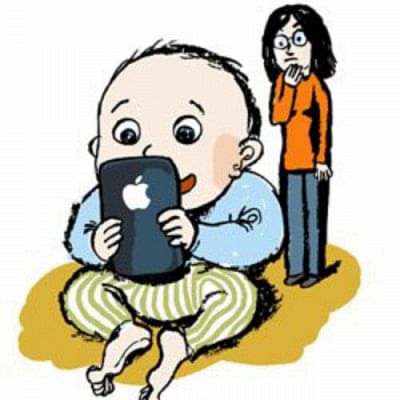Drawing the line

Parenting is one of the hardest jobs in the world – that is, when someone is planning to do it right. It is a labour-intensive job, and it incorporates aspects of many other jobs, including teacher and nurse and coach and cheerleader, to name just a few. And as technology advances, it brings new implications in terms of parenting responsibilities.
Whether we are speaking of tablets, iPads, or mobile phones, handheld devices are becoming increasingly familiar to the children of today. In a way, they are a natural fit. The technology is designed to be user-friendly, and children have both an intuitive sense of how to use them, and a lack of inhibition. Unlike adults, who worry about looking foolish if they make a mistake. More than one father has proudly told me how his child under five uses the touchscreen on his tablet with the greatest confidence.
I do understand parents' desire for their children to keep up with others in the increasingly competitive and tech-savvy world in which we operate. But in allowing children access to handheld devices, there are several things that adults need to keep in mind. Not least the fact that a leading occupational therapist in the US recently wrote an article in the Huffington Post explaining why children below the age of 12 years should not be given access to handheld devices.
I can hear a collective groan going up at the prospect of such a ban. And I know that many will argue that allowing kids to use mobile phones to play games, or tablets to download things, is a good way of keeping them occupied for long periods of time, (particularly in Dhaka's ubiquitous traffic jams). To such arguments, I would humbly suggest that anybody who wants to prioritize the welfare of a child should instead inculcate in them the habit of reading. Not only will this keep them happily entertained for long periods of time, it will also help them learn more about the world around them, and improve their reading speed and concentration. As an added bonus, the latter is likely to be helpful for them in their studies as well.
Here are a couple of things to keep in mind before allowing children to use handheld devices, especially for any length of time. Firstly, there can be implications for their health. Not only does staring at a computer screen encourage sedentary behaviour and over-stimulate children – thereby contributing to obesity and concentration problems during school hours, respectively – it can also lead to repetitive strain injury and related pain issues in the long term. And the long term isn't as distant as you might think! For example, I spoke to a physiotherapist who has had to treat several children for inflammation in their thumbs due to gaming. It now requires a daily application of ice to the hands in order to reduce the pain.
To make matters worse, and this brings me to my second point, as most adults who use computers a lot will admit, technology is addictive. As a result, despite the pain, the children go on playing these games. But such addictions also impact their behaviour. A friend of mine admits that before her ten-year old twins go to bed, the parents have to do a "pat down" to make sure there are no hidden mobile phones or tablets that they are trying to sneak into their bedroom. Often, one of the boys will come out after bedtime, allegedly for a drink of water or to use the bathroom, and will later be found to have smuggled in one of the devices in order to continue playing.
So while many people think that it is cute to see how good children are at handling technology, it is worth also finding out how it impacts their health and behavior. Given how some adults behave with Facebook, it shouldn't be difficult to understand why a child would get addicted to technology. I would like to point out the books, on the other hand - however addictive - involve none of these nasty side effects...!
Farah Ghuznavi is the author of Fragments of Riversong (2013) and editor of Lifelines (2012). Writer in Residence with Commonwealth Writers, her work has been published in Asia, Europe and N. America.

 For all latest news, follow The Daily Star's Google News channel.
For all latest news, follow The Daily Star's Google News channel. 








Comments